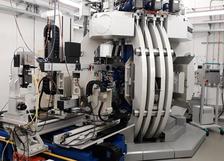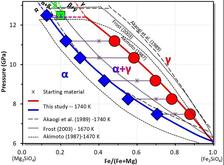The Large Volume Press (LVP) 'Aster-15' at the PETRA III beamline P61B. A sample (in the middle) would be compressed by the blue rams and the X-rays come from the right, behind the press (Photo: DESY).
A research team from DESY and the Bayerisches Geoinstitut (University of Bayreuth) headed by Tomoo Katsura, studied an important transformation in olivine, the most abundant mineral on the Earth. At PETRA III, they determined the phase relations between olivine and its high-pressure modification, ahrensite, at 1740 K in the pressure range of 7.5–11.2 GPa. These are the first published results using synchrotron radiation at the PETRA III beamline P61B for measurements in the Large Volume Press ‘Aster-15’ since the operation for users started in Autumn 2020. The findings are published in the journal ‘Contributions to Mineralogy and Petrology’.
Olivine (Mg,Fe)2SiO4 is one of the most abundant minerals in the upper layers of terrestrial planetary interiors. Although olivine is predominantly magnesium enriched in the Earth’s mantle, it is more iron enriched in other planets, such as Mars. With increasing depth, iron-rich olivine transforms into a spinel-structured high-pressure phase, ahrensite. Knowledge regarding the phase relationships of abundant mantle minerals is crucial for understanding planetary structures and dynamics, which are otherwise not accessible. Therefore, a detailed investigation of the olivine-ahrensite transition is required for studies of iron-rich planets. Olivine-ahrensite paragenesis has also been reported in many meteorites. The formation mechanism of paragenesis provides clues regarding the origin of such meteorites. A precise determination of the olivine-ahrensite phase transition thus allows meteorite impact conditions to be estimated.
The research team investigated high-pressure and high-temperature olivine-ahrensite phase relations using the Large Volume Press (LVP) at the beamline P61B. Olivine samples with different compositions were compressed to 7.5–11.2 GPa and then heated to 1740 K. The sample pressures were determined using in situ X-ray diffraction. After the experiments where olivine and ahrensite were observed to stably coexist, the compositions of these minerals were determined by electron probe microanalysis using a scanning electron microscope.
To quantitatively determine pressure and temperature conditions from the compositions of coexisting olivine and ahrensite, a software was developed. It is based on the achieved results and thermodynamic calculations. By using this software (“Olivine–ahrensite loop calculation tool”) scientists attempted to evaluate the shock conditions from published data for compositions of coexisting olivine and ahrensite in Martian meteorites and chondrite meteorites. They first estimated the shock temperatures based on the Fe-Mg partition coefficients between these minerals, and subsequently obtained shock pressures using these temperatures as well as the magnesium content.
The determined olivine-ahrensite relationship ratio in a wide pressure-temperature range is valuable not only for planetary science, but also for high-pressure technology. It eases in particular the calibration of high-pressure apparatuses at high temperatures. Conventionally, mineral phase transition measurements have to be repeatedly conducted several times with variable press loads. Using olivine solid solutions, it is possible to precisely determine the pressure in a single run using the measured compositions of coexisting olivine and ahrensite.
Original publication:
Determination of phase relations of the olivine–ahrensite transition in the Mg2SiO4–Fe2SiO4 system at 1740 K using modern multi‑anvil techniques, A. Chanyshev, D. Bondar, H. Fei, N. Purevjav, T. Ishii, K. Nishida, S. Bhat, R. Farla, and T. Katsura, Contributions to Mineralogy and Petrology (2021), DOI: https://doi.org/10.1007/s00410-021-01829-x








